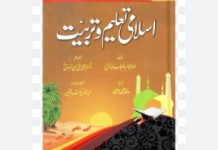Naira Eshaal
Pakistan has been facing many problems that hinder its development. However, we may identify these problems and try to suggest some doable policies for making it stand with pride on an international scale.
Let us discuss briefly what are the issues hindering its development. It has a weak economy, political instability, and there are governance issues. All these are aggravated by adverse climate change effects. Massive public debt is also an old problem. We take loans to pay off the old loans. What can be more harsher fact than this reality? In such a scenario, the loans acquired cannot be used for development purposes. There are low foreign exchange reserves and high poverty levels.
Seeing all these, there is a great need for economic reforms and the adoption of an export-led economic growth model. The female participation in the workforce should be increased. There is also a need for climate adaptation and investment in renewable energy sources to minimize the energy crisis and reduce reliance on thermal fuel. Water management strategies should also be adopted for a good infrastructure, like dams and fighting natural disasters.
It is also a reality that special economic zones and export promotion zones play an important role in economic revival and industrial growth, as they help in attracting foreign direct investment. Tax incentives should be given, and regulations should be simplified. Infrastructure must be developed. It is necessary that, for a strong economy, more employment opportunities are generated and technology transfer avenues are created. Industrial clusters must be created to enhance productivity and competitiveness.
Many examples in Pakistan can be cited in this regard, like SEZ under Rashakai, Dhabeji, and Allama Iqbal SEZ. These are designed to revive industrial output and make the economy export-driven. In this way trade deficit is also reduced. Domestic production of goods must be enabled.
There is also a need for export diversification and improvement of the balance of payments. Export Promotion zones are designed for export-oriented production. They facilitate industries and give wider access to international markets. They increase foreign exchange earnings and diversify exports and Agri-processing.
There is a need to strengthen Pakistan’s competitiveness in international supply chains through lower production costs. In Pakistan, Karachi Export Processing Zone and Sialkot Export Processing Zone show how targeted incentives can create export hubs. They encourage value added exports leading to stabilization of the currency. Industrial activity gives way to creation of employment and it promotes skill development and empowerment of women and youth in the manufacturing sectors.
In the context of Pakistan, one suggestion can be placement of these special economic zones near educational institutions can lead to improving technical education and skill upgrading through industry-academia linkages. In this way, the education is aligned with market needs and poverty is reduced. The urban and rural employment gap is also bridged.
There is a need for institutional efficiency as both SEZ and EPZ work through autonomous management authorities. Hence, there is more transparency and efficient administrative processes which are involved, which are often not seen in many other government departments.
One window operations lead to decreasing bureaucratic hurdles and minimizing corruption. One suggestion is to strengthen the Board of Investment and zone authorities. Here, digital transparency tools can improve governance outcomes nationally. Pakistan should also try for climate resilience and green industrialization. Modern SEZs can be designed as eco industrial parks. Emphasis should be on clean energy and production practices that are sustainable.
There must be the use of low-emission technologies that can make SEZs models of green growth. Climate-smart infrastructure in these Special Economic Zones would facilitate the country to integrate it with low low-carbon industrial strategy. There is also a need for strengthening regional connectivity as the Special Economic Zones are placed near transparent corridors, ports, and borders. Regional integration opportunities are improved in this manner. One example is the East-West Economic Corridor linking South Asia with Central Asia. Transit trade and cross-national value chains must be facilitated, thus leading to an increase in Pakistan’s strategic and economic relevance in the region.
Islamabad is connected through the M-1 and M-2 motorways, thus connecting with Faisalabad, Lahore, and Peshawar. In this manner, it becomes a central unit from administrative and logistic point of view. SEZ and EPZ may be developed in northern Pakistan also. ICT can work as a policy and regulatory center with institutions like BOI, CPEC Authority and Ministries of Industries and Production for maintaining SEZs and EPZs, as it is near Rawal Industrial Estate and the upcoming Hattar SEZ in Haripur, allowing it to support these through policy, research, and manpower that is skilled.
Hattar Special Economic Zone is around 50 km from Islamabad. Islamabad also offers employment opportunities for the citizens of Rawalpindi and it encourages collaboration between research institutions in Islamabad and manufacturing companies in Hattar in areas of technology and energy. It has an industrial area in I-9 and I-19 and the Kahuta Triangle. These can be exploited as mini–Export Promotion Zones. These zones may focus on software exports compatible with the goals of Pakistan’s digital economy and handicrafts, electronic assembly, etc. These zones can link the production with the ecosystem of academia. Through linking these clusters with the national development framework, the capital city can prove to become a model knowledge-based Export Processing Zone with an emphasis on manufacturing of low-carbon exports. Islamabad hosts the decision-making machinery, so it has an edge in asserting a regulatory and facilitative role for EPZs and SEZs.
A suggestion is that Islamabad Technology and Export Zone (ITEZ) can be created with a focus on IT exports, software development, digital services, biotechnology, pharmaceuticals, and renewable energy components. Partnerships with foreign investors for state-of-the-art manufacturing under CPEC Phase II can also be a good step.

















